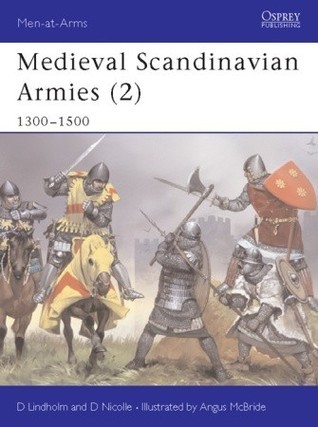Medieval Scandinavian Armies (2) 1300-1500
 Much like the first book, this is a solid but unspectacular Men-At-Arms volume.
Much like the first book, this is a solid but unspectacular Men-At-Arms volume.
The Angus McBride art is better this time, with one two-page spread battle scene (shown in part on the cover). There’s a couple where the backgrounds aren’t detailed, but Plate A depicts (in not a lot of detail) a group on one of the smaller ships of the 1300s in the North Sea, which is a plus.
Again, most of the photos are of period illustrations and carvings rather than actual artifacts. But there are some, and they tend to be varied and useful, including a light canon taken from a Danish shipwreck. There’s also several photographs of period fortifications, since more of them were made in stone in this period, and have thus survived.
The chronology section is very extensive and runs over four pages (all with illos…). Certainly, this is an excellent first stop for finding out what was happening in Scandinavia in the period, and covers the outlines of the failing settlements in Greenland.
The opening section deals with the politics of the region, notably the Union of Kalmar, and Scandinavia breaking into western Denmark/Norway, and eastern Sweden/Finland in the Fifteenth Century. The rest of the text naturally deals with the usual Osprey focus on military equipment and organization. It’s well done, but there’s not necessarily any surprises here; by this point Scandinavia was more integrated with the rest of Europe, so technology and fashions are no longer lagging so far behind. On the other hand, interior roads were still few and underdeveloped, so the control of blocking positions was still important. At the same time militia was becoming more important, and later rebellions razed many wooden fortifications, prompting their replacement with stone castles in areas with a stronger economy.

Discussion ¬